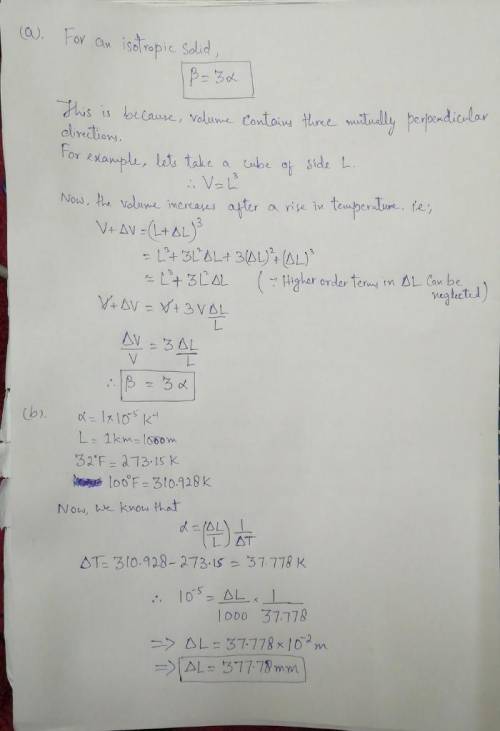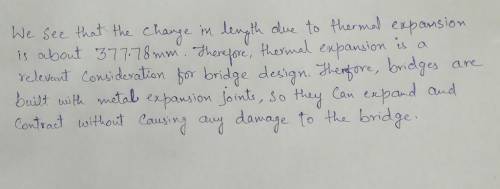
Physics, 29.01.2020 06:49 tiarafaimealelei
For a solid, the linear thermal expansion coefficient α measures the fractional increase in length per degree:
α ≡ (∆l/l)/∆t
where ∆l is a change in length, l is the length, and ∆t is the change in temperature.
a similar coefficient may be derived for the volume v , which changes an amount ∆v when we change the temperature by ∆t:
β = (∆v/v)/∆t
such a coefficient is especially useful for describing the thermal properties of fluids. (note: you may take the changes to be small. indeed, we’ll eventually be interested in infinitesimal changes so that things like ∆l turn into derivatives.)
(a) derive the relationship between α and β for an isotropic solid (i. e., one for which α does not depend on the direction in the material which we measure it).
(b) for a piece of concrete, the linear thermal expansion coefficient is about α = 1 × 10−5 k−1. imagine now a concrete bridge that is 1 kilometer long. what is the variation in length ∆l for this concrete bridge between a freezing cold temperature of 32◦f and a hot, summer temperature of 100◦f? is thermal expansion a relevant consideration for bridge design?

Answers: 1
Another question on Physics

Physics, 22.06.2019 11:50
Two resistors r1 and r2 may be connected either in series or parallel across an ideal battery with emf ε. we desire the rate of energy dissipation of the parallel combination to be 8.75 times that of the series combination. if r1 = 105 ω, what are the (a) smaller and (b) larger of the two values of r2 that result in that dissipation rate?
Answers: 2

Physics, 22.06.2019 23:40
Certain bacteria (such as aquaspirillum magnetotacticum) tend to swim toward the earth’s geographic north pole because they contain tiny particles, called magnetosomes, that are sensitive to a magnetic field. if a transmission line carrying 100 a is laid underwater, at what range of distances would the magnetic field from this line be great enough to interfere with the migration of these bacteria? (assume that a field less than 5% of the earth’s field would have little effect on the bacteria. take the earth’s field to be 5.0 * 10-5 t, and ignore the effects of the seawater.)
Answers: 1


Physics, 23.06.2019 05:40
What is the change in internal energy if 20 j of heat is released from a system and the system does 50 j of work on the surroundings? a. -70 j b. 30 j c. -30 j d. 70 j
Answers: 2
You know the right answer?
For a solid, the linear thermal expansion coefficient α measures the fractional increase in length p...
Questions

Social Studies, 22.01.2021 04:20

Mathematics, 22.01.2021 04:20

History, 22.01.2021 04:20

Mathematics, 22.01.2021 04:20



Mathematics, 22.01.2021 04:20

Chemistry, 22.01.2021 04:20

World Languages, 22.01.2021 04:20







History, 22.01.2021 04:20

Biology, 22.01.2021 04:20



Mathematics, 22.01.2021 04:20





